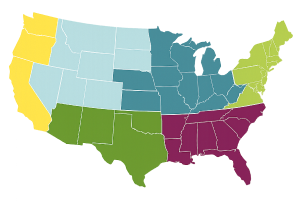
How do we use your location?
Knowing your location helps us recommend plants that will thrive in your climate, based on your Growing Zone.

Knowing your location helps us recommend plants that will thrive in your climate, based on your Growing Zone.
Many gardeners plant several butterfly bushes together, so they grow into a shrub-like clump with blooms in all the colors--purple, pink and white.
Butterfly Bush is a shrub-like plant that looks sort of like a compact lilac, grows quickly and blooms in mid-summer. But the name tells you all about it: Butterflies just can’t resist the flowers, and flock to the plants when they're in bloom.
The Magic: How the Butterfly Bush works: Buddleia or Butterfly Bush has been a sensation in American gardens for years, and no wonder. This plant is easy to grow, blooms profusely, and has that magical quality: Butterflies can’t resist it.
Here's why: It’s not just the pretty flowers that attract the butterflies, like any bright flower. Buddleias emit a special honey-scented fragrance that lures butterflies like a moth to a light, and then once there, they find the flowers super-rich in nectar.
A butterfly bush in the garden will often be seen with a mass of butterflies on the flowers, especially during hot sunny afternoons. Buddleias attract other insects too, like moths, and the reddish ones strongly attract hummingbirds. So it’s more than a name; it’s actually a botanical phenomenon.
As soon as your order is placed you will receive a confirmation email. You will receive a second email the day your order ships telling you how it has been sent. Some perennials are shipped as potted plants, some as perennial roots packed in peat. The ‘Plant Information’ section describes how that item will ship. All perennials and fall-planted bulbs are packaged to withstand shipping and are fully-guaranteed. Please open upon receipt and follow the instructions included.
Perennials and fall-planted bulbs are shipped at the proper planting time for your Growing Zone. Perennial and fall-planted bulb orders will arrive separately from seeds. If your order requires more than one shipment and all items are shipping to the same address, there is no additional shipping charge. See our shipping information page for approximate ship dates and more detailed information. If you have any questions, please call Customer Service at (802) 227-7200 or contact us by email or chat.